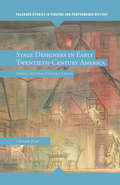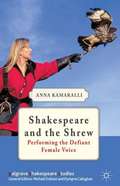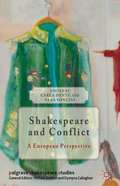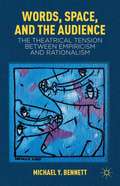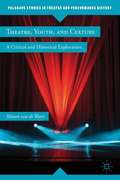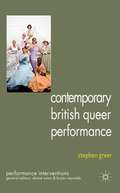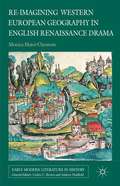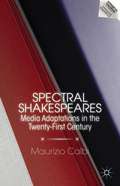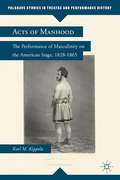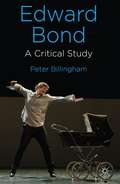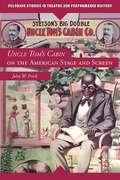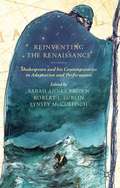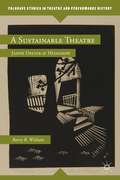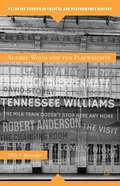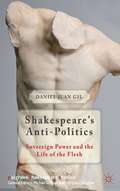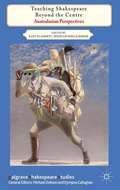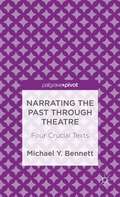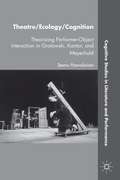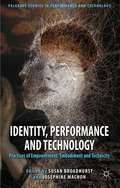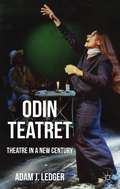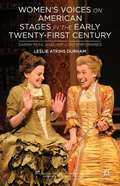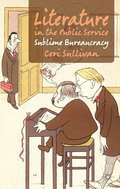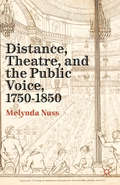- Table View
- List View
Stage Designers in Early Twentieth-Century America: Artists, Activists, Cultural Critics (Palgrave Studies in Theatre and Performance History)
by E. EssinBy casting designers as authors, cultural critics, activists, entrepreneurs, and global cartographers, Essin tells a story about scenic images on the page, stage, and beyond that helped American audiences see the everyday landscapes and exotic destinations from a modern perspective.
Shakespeare and the Shrew
by Anna KamaralliWhenever Shakespeare wrote a 'shrew' into one of his plays he created a character who challenged ideas about acceptable behaviour for a woman. This is as true today as when the plays were first performed. A shrew is a woman who refuses to be quiet when she is told to be, who says things that people do not want to hear. She is constructed to alleviate male anxieties through ridicule, but like so many objects of comedy or derision, she is full of power because of her very ability to generate these anxieties. 'Shrew' is supposed to be an insult, but has often been used to describe women enacting behaviour that can be brave, clever, noble or just. This book marries an examination of Shakespeare's shrews in his plays with their history in recent performance, to investigate our own attitudes to hearing women with defiant voices.
Shakespeare and Conflict
by Carla Dente Sara SonciniWhat has been the role played by principles, patterns and situations of conflict in the construction of Shakespeare's myth, and in its European and then global spread? The fascinatingly complex picture that emerges from this collection provides new insight into Shakespeare's unique position in world literature and culture.
Words, Space, and the Audience
by Michael Y. BennettIn this unique study, Michael Y. Bennett re-reads four influential modern plays alongside their contemporary debates between rationalism and empiricism to show how these monumental achievements were thoroughly a product of their time, but also universal in their epistemological quest to understand the world through a rational and/or empirical model. Bennett contends that these plays directly engage in their contemporary epistemological debates rather than through the lens of a specific philosophy. Besides producing new, insightful readings of heavily-studied plays, the interdisciplinary (historical, philosophical, dramatic, theatrical, and literary) frame Bennett constructs allows him to investigate one of the most fundamental questions of the theatre - how does meaning get made? Bennett suggests that the key to unlocking theatrical meaning is exploring the tension between empirical and rational modes of understanding. The book concludes with an interview with performance artist Coco Fusco.
Theatre, Youth, and Culture
by Manon van de WaterThere is a complex relationship between performance, youth, and the shifting material circumstances (social, cultural, economic, ideological, and political) under which theatre for children and youth birth through twenties is generated and perceived. Offering multiple, intersecting narratives, this book explores different aspect of theatre for young audiences (TYA) using examples from theatrical events in different geographical regions. The discussion of the history, theory, and practice of TYA indicates the wide variety of hitherto under-researched topics in the growing field of professional theatre for young people. "
Contemporary British Queer Performance
by Stephen GreerIf the 1970s saw the first appearance of lesbian and gay dramas, the 1990s have seen the rise of a broader but more troublesome claim on queer performance. If no longer tied to the politics of 'coming out' and the question of visibility, for whom and how does queer performance act? Drawing on queer theory's questioning of identity, representation and authenticity, this volume presents a genealogy of performance practice which begins in discussion of Gay Sweatshop (the UK's first openly lesbian and gay theatre company) before turning to examine where its foundational priorities and aspirations have been transformed in works and practice of the last twenty years. Grounded in practitioner and audience accounts of performance, this book examines works produced in a range of new contexts to argue for the significance of collaborative practices across Britain: as national and community histories; as protest and activism; as theatre-in-education and applied theatre; and within the UK's queer arts festivals.
Re-imagining Western European Geography in English Renaissance Drama
by Monica Matei-ChesnoiuFocusing on how citizens of early modern England tried to locate themselves and their nation through geography and travel writing, Monica Matei-Chesnoiu explores theatrical representations of Western European space and ethnography. Geographic discourses share many features with drama in that they appeal to the readers' and audience's curiosity and imagination. Playwrights use information derived from geography treatises as vehicles to allegorize contemporary English issues in a dialogical mode. While geography and travel texts provide an objective synthesis in describing Western European nations, dramatic interaction destabilizes any preconceived notions and submits contrastive views on imagined global European communities. This book explores representations of France, Spain, Germany, the Low Countries, and Denmark in a wide range of geography texts and offers fresh readings of Shakespeare, Jonson, Marlowe, Middleton, Dekker, Massinger, Marston, and others.
Spectral Shakespeares
by Maurizio CalbiSpectral Shakespeares is an illuminating exploration of recent, experimental adaptations of Shakespeare on film, TV, and the web. Drawing on adaptation studies and media theory as well as Jacques Derrida's work, this book argues that these adaptations foreground a cluster of self-reflexive "themes" - from incorporation to reiteration, from migration to addiction, from silence to survival - that contribute to the redefinition of adaptation, and Shakespearean adaptation in particular, as an unfinished and interminable process. The "Shakespeare" that emerges from these adaptations is a fragmentary, mediatized, and heterogeneous presence, a spectral Shakespeare that leaves a mark on our contemporary mediascape.
Acts of Manhood
by Karl M. KippolaExploring the performance of masculinity on and off the nineteenth-century American stage, this book looks at the shift from the passionate muscularity to intellectual restraint as not a linear journey toward national refinement; but a multitude of masculinities fighting simultaneously for dominance and recognition.
Performing Site-Specific Theatre
by Joanne Tompkins Anna BirchThis book investigates the expanding parameters for site-specific performance to account for the form's increasing popularity in the twenty-first century. Leading practitioners and theorists interrogate issues of performance and site to broaden our understanding of the role that place plays in performance and the ways that performance influences it
Edward Bond: A Critical Study
by Peter BillinghamThis new study of one of Britain's greatest modern playwrights represents the first major, extended discussion of Edward Bond's work in over twenty years. The book combines rigorous and stimulating analysis and discussion of Bond's plays and ideas about drama and society. For the first time, there is also discussion of selected plays from his later, post-2000 period, including Innocence and Have I None, alongside explorations of widely studied plays such as Saved.
John Banville’s Narcissistic Fictions: The Spectral Self
by Mark O’ConnellIn reading Banville's novels through the work of key psychoanalytical theorists, John Banville's Narcissistic Fictions brings together apparently disparate thematic strands - missing twins, shame, false identities - and presents these as manifestations of a central concern with narcissism.
Uncle Tom’s Cabin on the American Stage and Screen
by John W. FrickNo play in the history of the American stage has been as ubiquitous and as widely viewed as Uncle Tom's Cabin. This book traces the major dramatizations of Harriet Beecher Stowe's classic from its inception in 1852 through "modern" versions on film. Frick examines the major productions, companies, and influential persons in the long, complex history of theatrical Toms, providing a broad overview of what has been labeled the "Uncle Tom phenomenon. " Unlike previous studies about Uncle Tom's Cabin, Frick introduces the reader to the artists who created the plays and productions that created theatre history.
Reinventing the Renaissance
by Sarah Annes Brown Robert I. Lublin Lynsey MccullochThe plays of Shakespeare and his contemporaries has inspired interpretations in every genre and medium. This book offers perspectives on the ways in which practitioners have used Renaissance drama to address contemporary concerns and reach new audiences. It provides a resource for those interested in the creative reception of Renaissance drama.
A Sustainable Theatre
by Barry B. WithamBegun as an audacious experiment, for thirty years the Hedgerow Theatre prospered as America's most successful repertory company. While known for its famous alumnae (Ann Harding and Richard Basehart), Hedgerow's legacy is a living library of over 200 productions created by Jasper Deeter's idealistic and determined pursuit of 'truth and beauty. '
Audrey Wood and the Playwrights
by Milly S. BarrangerFrom Tennessee Williams and Carson McCullers to Arthur Kopit and Brian Friel, agent Audrey Wood encouraged and guided the unique talents of playwrights in the Broadway theatre of her day. Her quiet determination and burning enthusiasm brought America's finest mid-century playwrights to prominence and altered stage history.
Shakespeare’s Anti-Politics
by Daniel Juan GilArgues that Shakespeare is anti-political, dissecting the nature of the nation-state and charting a surprising form of resistance to it, using sovereign power against itself to engineer new forms of selfhood and relationality that escape the orbit of the nation-state. It is these new experiences that the book terms 'the life of the flesh'.
Teaching Shakespeare Beyond the Centre
by Penny Gay Kate Flaherty L. E. SemlerShowcasing a wide array of recent, innovative and original research into Shakespeare and learning in Australasia and beyond, this volume argues the value of the 'local' and provides transferable and adaptable models of educational theory and practice.
Narrating the Past through Theatre
by Michael Y. BennettThis cutting-edge title explores how narrating the past both conflicts and creates an interesting relationship with drama's 'continuing present' that arcs towards an unpredictable future. Theatre both brings the past alive and also fixes it, but through the performance process, allowing the past to be molded for future (not-yet-existent) audiences.
Theatre/Ecology/Cognition
by Teemu PaavolainenHow is performer-object interaction enacted and perceived in the theatre? How thereby are varieties of 'meaning' also enacted and perceived? Using cognitive theory and ecological ontology, Paavolainen investigates how the interplay of actors and objects affords a degree of enjoyment and understanding, whether or not the viewer speaks the language.
Identity, Performance and Technology
by Susan Broadhurst Josephine MachonThis project investigates the implications of technology on identity in embodied performance, opening up a forum of debate exploring the interrelationship of and between identities in performance practices and considering how identity is formed, de-formed, blurred and celebrated within diverse approaches to technological performance practice.
Odin Teatret: Theatre in a New Century
by Adam J. LedgerFocusing on Odin Teatret's latest work, this discussion is updated by drawing on fresh research. The group's productions since 2000 are included and the book offers a reassessment of Odin's actor training. Its community work and legacy are discussed and Barba's intercultural practice is viewed alongside two major Theatrum Mundi productions.
Women’s Voices on American Stages in the Early Twenty-First Century
by Leslie Atkins DurhamWomen have claimed a spot at the center of American theatre, and the characters they craft, the stories they tell, the questions they pose, and the ideas they materialize have the potential to shape the cultural imagination of a large group of theatre-goers as a complex new era unfolds. Sarah Ruhl is the early twenty-first century's most widely produced and frequently honored American female playwright. While critics have heretofore emphasized the whimsical elements of her dramaturgy, this study highlights her feminist engagement with current social and ethical concerns. Ruhl's popular, feminist plays are best appreciated when they are read in concert with the work of her contemporaries - Lisa Loomer, Diana Son, Joan Didion, Jenny Schwartz, Young Jean Lee, Kate Fodor, Yasmina Reza, Bathsheba Doran, Lynn Nottage, and Kia Corthron - whose writing also wrestles with the vexing issues facing Americans in the new century.
Literature in the Public Service
by Ceri SullivanHistorians and sociologists have been consistently - albeit gloomily - enthralled by Max Weber's model of the inevitable rise of the neurocrat. However, literary critics positively boast that writers, like academics, cannot 'do admin'. While Weber's thesis about the rise of the entrepreneur all fire, individuality, thrust is in tune with what we think literature is about, his thesis about the rise of the bureaucrat is not. Yet 'creative bureaucracy' is not only a euphemism for bending the rules. Literature in the Public Service shows how the public service makes its workers original, taking them beyond an individuated point of view to imagine the perfect public system. Creativity theorists too have swapped the model of solitary inspiration for a managed creative environment. John Milton, Anthony Trollope, and David Hare are examples of how authors work in and write about the public service, during its crisis moments. "
Distance, Theatre, and the Public Voice, 1750–1850
by M. NussAs theatres expanded in the eighteenth and nineteenth centuries, the distance between actor and audience became a telling metaphor for the distance emerging between writers and readers. Nuss explores the ways in which theatre helped authors imagine connecting with a new mass audience.
